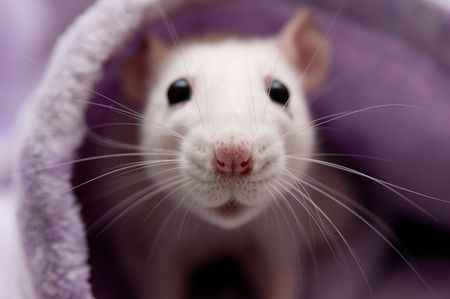Sneezing could signify many things. Just like humans, it could mean that they’re just getting used to their new environment. However, frequent sneezing could also signify the beginning of something dangerous.
Reasons Why Rats Sneeze a Lot
Here’s why:
A new home can cause rats to sneeze.
When you bring your new rat home (or if you just moved into a new house), your rat may sneeze as he is adjusting to the new smells and allergens.
If your rats sneeze once in a while, it could be that they’re allergic to something in your home. Some things to avoid with rats are cigarette smoke, perfume, soap, certain shampoos, carpet shampoo, dust, other animals, etc.
Some bedding advertised for rats are actually dangerous.
Pine or cedar bedding is very damaging to a rat’s internal organs. Remove them from the bedding immediately.
Aquarium tanks don’t allow for good ventilation which also leads to ammonia build up. I highly suggest getting a wired cage that has adequate air flow.

Rats are susceptible to upper respiratory infections (URI)
URIs are common in rats and can lead a healthy rat to death in 24 hours in the worse cases. Rats have extremely sensitive respiration and are prone to bacterial infections and viruses. Most of the time, they are unable to fight off the infection on their own.
Read more here about dealing with sick rats.
Causes of upper respiratory infections in rats
- Mycoplasma
Mycoplasma is the bacteria that cause most infection. All pet rats carry the mycoplasma and the only rats that don’t are special laboratory bred rats. Some rats live a long time without being affected by it but there are the rats that will die if not treated promptly.
Mycoplasmosis is a chronic and gradual disease. It lies dormant until the rat’s immune system is compromised or weakened by things such as improper bedding, diet, overcrowding, ammonia build up due to infrequent cage cleaning, poor genetics (pet store and irresponsibly bred rats), and weakness due to old age.
Left untreated, it can develop into pneumonia, a lower respiratory infection, which has taken many ratty lives.
Once it has progressed into a pneumonia, the damage to their lungs is usually permanent and the rat may have to frequently be treated with increasingly stronger courses of antibiotics.
The first sign of an URI is often sneezing. Other signs and symptoms are the sneezing persisting or progressing into clicking, gasping, wheezing, coughing, labored breathing, or other signs of illness such as squinting, puffed fur, lethargy, and porphyrin (blood-looking) staining around the eyes and nose.
Be sure to listen closely to your rat’s lungs for signs of pneumonia by holding them up to your ear like a telephone and listening to each lung.
Most of us here affectionately call this checkup “playing rat phone”. If signs are present, take the rat to the vet ASAP as the rat will require prescription antibiotics.
Sendai Virus
Sendai Virus has very similar symptoms to an URI but is rare and its progress and outbreaks are well tracked. SV is highly contagious and transmittable through contact and air, which is why it is very important to quarantine any new rats in a separate air space.
It is a descending respiratory infection, which begins in the nasal passages, and moves through the trachea into the lungs.
There is no treatment for SV. However, it is essential to treat immediately for secondary bacterial infections with broad-spectrum antibiotics as soon as an SV infection is noticed.




